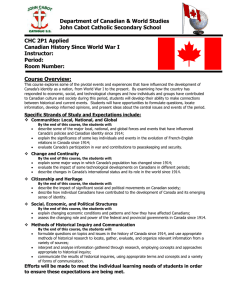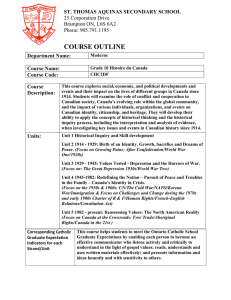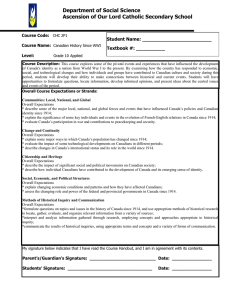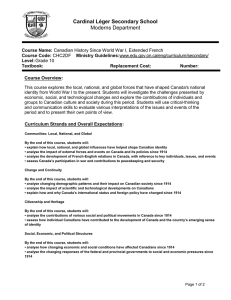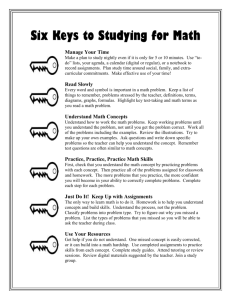Department of Canadian & World Studies John Cabot Catholic Secondary School
advertisement
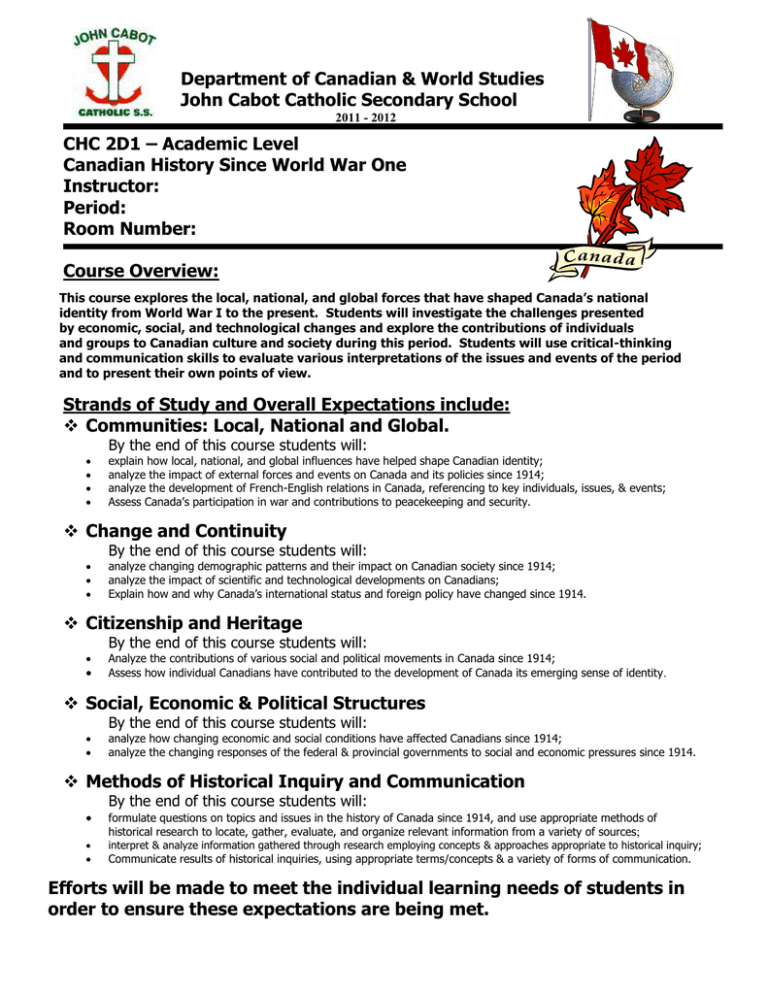
Department of Canadian & World Studies John Cabot Catholic Secondary School 2011 - 2012 CHC 2D1 – Academic Level Canadian History Since World War One Instructor: Period: Room Number: Course Overview: This course explores the local, national, and global forces that have shaped Canada’s national identity from World War I to the present. Students will investigate the challenges presented by economic, social, and technological changes and explore the contributions of individuals and groups to Canadian culture and society during this period. Students will use critical-thinking and communication skills to evaluate various interpretations of the issues and events of the period and to present their own points of view. Strands of Study and Overall Expectations include: Communities: Local, National and Global. By the end of this course students will: explain how local, national, and global influences have helped shape Canadian identity; analyze the impact of external forces and events on Canada and its policies since 1914; analyze the development of French-English relations in Canada, referencing to key individuals, issues, & events; Assess Canada’s participation in war and contributions to peacekeeping and security. Change and Continuity By the end of this course students will: analyze changing demographic patterns and their impact on Canadian society since 1914; analyze the impact of scientific and technological developments on Canadians; Explain how and why Canada’s international status and foreign policy have changed since 1914. Citizenship and Heritage By the end of this course students will: Analyze the contributions of various social and political movements in Canada since 1914; Assess how individual Canadians have contributed to the development of Canada its emerging sense of identity. Social, Economic & Political Structures By the end of this course students will: analyze how changing economic and social conditions have affected Canadians since 1914; analyze the changing responses of the federal & provincial governments to social and economic pressures since 1914. Methods of Historical Inquiry and Communication By the end of this course students will: formulate questions on topics and issues in the history of Canada since 1914, and use appropriate methods of historical research to locate, gather, evaluate, and organize relevant information from a variety of sources; interpret & analyze information gathered through research employing concepts & approaches appropriate to historical inquiry; Communicate results of historical inquiries, using appropriate terms/concepts & a variety of forms of communication. Efforts will be made to meet the individual learning needs of students in order to ensure these expectations are being met. Course Breakdown Resources: Unit One: World War One Canada Before the War False Glory Conflict and Change at Home Unit Two: Boom and Bust The Twenties: A Decade of Change The Great Depression Unit Three: World War II Causes of World War II Events of World War II The War at Home Unit Four: Pursuing Peace and Prosperity Peace and Security Booming Fifties The Sixties: A Decade of Change Unit Five: Canada at the Crossroads Promise and Problems Politics and Economics Face of Modern Canada Redefining Canada The course will use a variety of resources including video, CD-ROM, Internet Applications and a variety of print sources. The textbook Canada: Face of a Nation will be distributed to students during the first week of the course. The text and all other resources assigned to students are the responsibility of the student. Any damage incurred will result in payment for replacement. The replacement cost for the text is $50.00. Evaluation Structure:: Knowledge Thinking Communication Application 20% 30% 30% 20% The above is reflected both in the term work (worth 70% of the final mark) and the summative work (worth 30% of the final mark). Summative work consists of the Final Exam (20%) and a Culminating Activity (10%). Assessment & Evaluation Policy Students will be assessed & evaluated according to the work produced & skills displayed. Methods of providing feedback will include assessing work in process & evaluating completed assignments, tests, co-operative learning activities, simulations and presentations. Peer & self-assessments will also be utilized. Student marks will be determined by evaluating product according to 4 categories & 4 levels. Please see the chart below for specific skills and key words used to determine student competency in the different categories. Level Category Knowledge/Understanding Knowledge of content Understanding of content Thinking Critical/creative thinking skills Planning Skills Processing Skills Communication Level 1: 50-59% Level 2: 60-69% Level 3: 70-79% Level 4: 80-100% demonstrates/ expresses knowledge and skills with limited effectiveness demonstrates/ expresses knowledge and skills with some effectiveness demonstrates/ expresses knowledge and skills with considerable effectiveness demonstrates /expresses knowledge and skills with thorough effectiveness Expression and organization of ideas and information (oral, written & visual) Communication for different audiences/purposes Use of conventions of form, vocabulary & terminology Application Application of knowledge/skills in familiar contexts Transfer of knowledge/skills to new contexts Making connections within and between various contexts Feedback will also be provided for student learning skills. Skills like working independently, team work, organization, work habits and homework, and initiative are assessed independently student achievement and will be conducted through the use of a rubric indicating specific criteria to be achieved to receive each of the following letter grades: E –Excellent G – Good S – Satisfactory N - Needs Improvement Fair Evaluation Practices LATE ASSIGNMENTS Assignments submitted after the Primary Due Date established by the teacher will be accepted with a penalty of no more than 10%. This four day Penalty Zone is the maximum time allowed for submissions. If the teacher returns the marked assignments within a reasonable time frame, the date of return is considered the closure date. The assignment should still be submitted so that the student can receive feedback. Repeated lateness in submissions indicates poor organization skills and will result in parental contact and will be reflected in the learning skills section of the report card. INCOMPLETE/MISSED ASSSIGNMENTS Assignments will be graded according to the extent with which they meet the criteria established in the rubric or evaluation structure. Students who miss several assignments may be given other opportunities to demonstrate their understanding of curriculum expectations. MISSED TESTS Tests missed with a legitimate reason will be written within a few days of the student returning from the absence. Student eligibility to write the test and the date of writing will be at the discretion of the teacher in consultation with the department head and/or administrator. PLAGIARISM in any form reflects academic dishonesty and will result in a mark of zero for the assignment in question. EVALUATION OF SUSPENDED STUDENTS / VACATIONS: Refer to Student and Parent Handbook 2010 – 2011.
